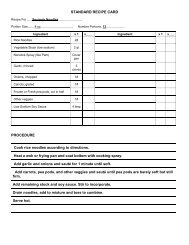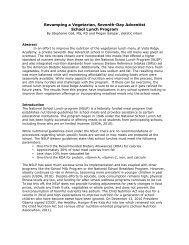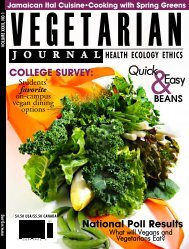An Update on Gelatin Top Restaurant Chains for Vegetarians
An Update on Gelatin Top Restaurant Chains for Vegetarians
An Update on Gelatin Top Restaurant Chains for Vegetarians
You also want an ePaper? Increase the reach of your titles
YUMPU automatically turns print PDFs into web optimized ePapers that Google loves.
taste when stored in plastic bags and can be refrigerated<strong>for</strong> up to two weeks.Parsnips offer a good amount of fiber, vitamin C,folate, manganese, and copper and small amounts ofir<strong>on</strong>. They also c<strong>on</strong>tain thiamin, niacin, potassium,and magnesium.You can serve parsnips raw like carrots, such asgrated <strong>for</strong> salads, or they can be sautéed, roasted, orsteamed. You can also mash and purée them into sidedishes or creamy soups. Parsnips’ dry texture can beenhanced with a little olive oil. Their flavor is best balancedwith a dash of nutmeg, cardamom, or cinnam<strong>on</strong>,but they can also take more savory flavors like curry.TURNIPS AND RUTABAGASTurnips and rutabagas are different, but these two rootvegetables have always been linked together. Look up<strong>on</strong>e, and you find the other.Turnips lived in prehistoric times and are white incolor. They appeared at the dinner table e<strong>on</strong>s be<strong>for</strong>erutabagas, which were first bred in the 17 th century.Rutabagas are a cross between turnips and wild cabbage.They are light purple at the top of the root and yellowbelow. Rutabagas became known as Swedish turnipsbecause of their popularity in that country, and theywere <strong>on</strong>e of the first vegetables new col<strong>on</strong>ists in Americagrew. But like Jerusalem artichokes and celeriac, rutabagasnever gained the wide following that carrots did.Rutabagas lack the pungent t<strong>on</strong>es of turnips, and thetaste is much sweeter. It’s a puzzle why they aren’tmore popular.Turnips and rutabagas aredifferent, but these tworoot vegetables have alwaysbeen linked together.Both turnips and rutabagas are good sources ofvitamin C. Select firm roots with few blemishes. Wash,but d<strong>on</strong>’t peel, these roots; then, grate them into saladsor steam, boil, bake, or roast them. One of my favoriteways to enjoy rutabagas is to slice them into thickmatchsticks to make baked rutabaga fries. Roast themwith a little oil at 350 degrees <strong>for</strong> approximately 25minutes. I have also successfully substituted or combinedmashed rutabagas with puréed pumpkin inpumpkin bread and muffin recipes.SWEET POTATOES (AND YAMS)The root of a vine in the morning glory family, sweetpotatoes can be traced back 10,000 years in SouthAmerica. Sweet potatoes grew in ancient Peru andare <strong>on</strong>e of the oldest recorded vegetables. Columbusbrought them back to Europe. During the followingcentury, Spanish and Portuguese explorers took sweetpotatoes to Africa. In the mid-20 th century, an orange,moist-fleshed variety was developed. We call thesebright orange sweet potatoes ‘yams,’ though they arenot true yams. Yams are actually large, white, starchytubers from Africa.Sweet potatoes are a good source of antioxidants,and they are high in beta-carotene. The darker thesweet potato, the higher the beta-carotene c<strong>on</strong>tent.They also offer a good amount of vitamins C and B 6and c<strong>on</strong>tain ir<strong>on</strong>, manganese, copper, and fiber.Buy firm, healthy-looking roots without blemishes.Store fresh sweet potatoes in a cool, dark, well-ventilatedplace but not in the refrigerator. Steam, bake, or roastuntil very tender. Cooked sweet potatoes keep <strong>for</strong>approximately three days in the refrigerator.ROSEMARY ROASTED ROOTS(Serves 4-6)This is an easy basic roasted vegetable recipe. I sometimestoss in a head of peeled garlic cloves. (These become sweeteras they roast.) You can also add a little more oil or changeyour choice of herbs. Try basil or oregano, or use a pinchof spices like nutmeg or cardamom <strong>for</strong> variati<strong>on</strong>.1 1 /2 pounds golden beets, carrots, Jerusalem artichokes, parsnips,sweet potatoes, rutabagas, or turnips, cut into bite-size chunks1 large <strong>on</strong>i<strong>on</strong> or 1 cup shallots, chopped (opti<strong>on</strong>al)1 or 2 Tablespo<strong>on</strong>s olive oil1 sprig fresh rosemary, leaves removed and chopped1 Tablespo<strong>on</strong> paprikaDash of cayenneSalt to tastePreheat oven to 350 degrees.Place cut vegetables in a large baking dish. Drizzlewith olive oil. Add rosemary and stir vegetables untilall are coated with oil. Sprinkle with paprika, cayenne,and salt. Stir again, and then bake <strong>for</strong> 1 hour or untilall vegetables are very tender.Total calories per serving: 141Carbohydrates: 19 gramsSodium: 68 milligramsFat: 4 gramsProtein: 3 gramsFiber: 5 grams8 Issue Four 2008 VEGETARIAN JOURNAL
















